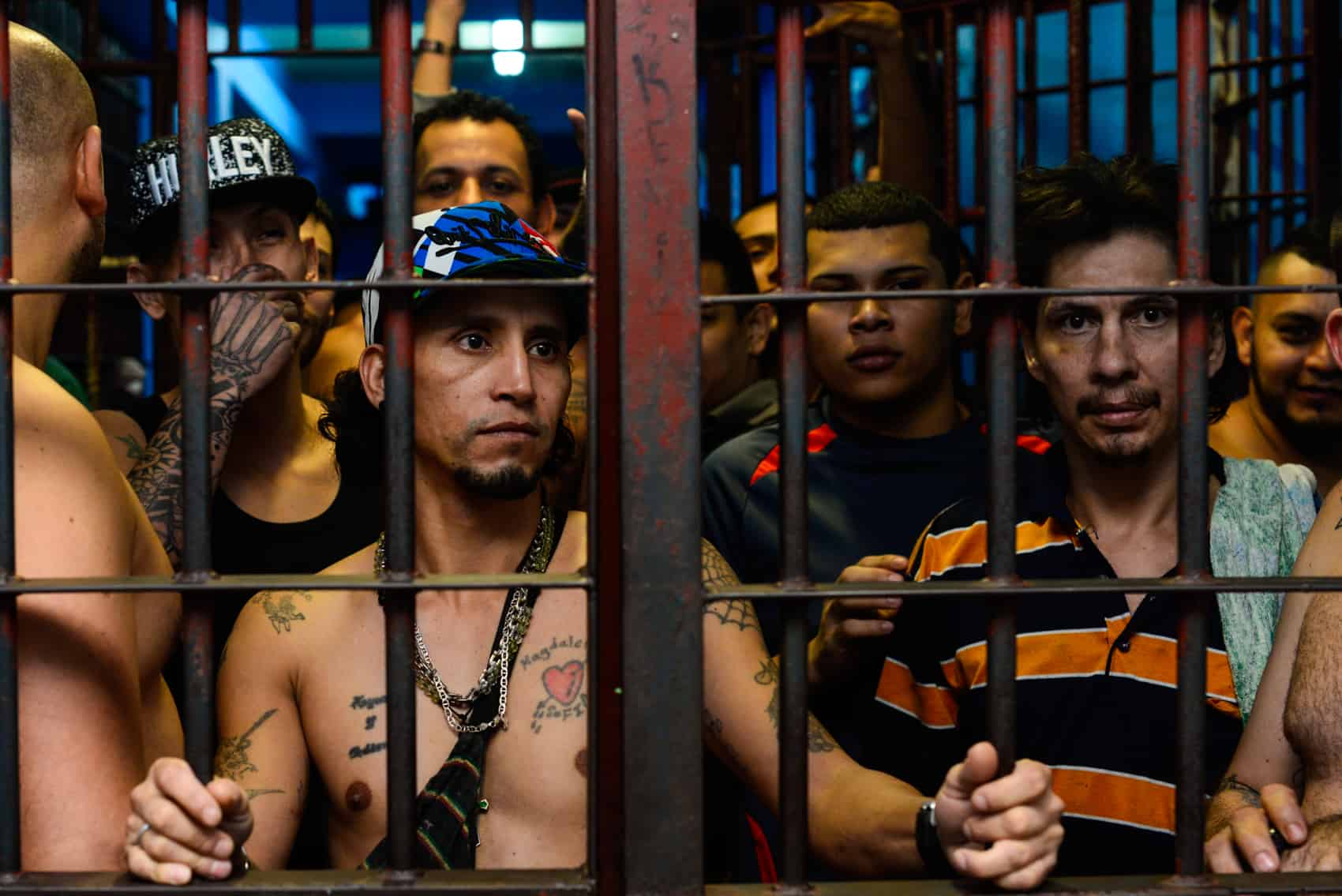He hated the heat more than anything. It was that time of night when he lay drenched in his own sweat on a thin piece of foam placed over the roach-ridden concrete while stuck in an overcrowded cell. That’s when it would get to him.
“Sometimes it makes you go crazy,” 35-year-old Byron Marín told The Tico Times in May, sitting in a break room in San José’s San Sebastián preventive prison. “The heat is incredible. With so many people in one room and without any type of ventilation, you’re always sweating. I’ve forgotten what it’s like to have a cool night.”
Marín, a street vender, spent nearly three months in pretrial detention after prosecutors said he stole a purse from a young woman in downtown San José.
He was accused of simple robbery, which carries a maximum sentence of nine years if violence was involved. He admits to the crime — he said he got desperate because he had no merchandise to sell. And yet two months after his arrest, his seemingly straightforward case “remained under investigation,” according to prosecutors.
It was Marín’s second offense: he had previously spent three years in prison for a separate robbery.
Before being released from San Sebastián on appeal in July, Marín was one of some 1,280 inmates in the country’s only prison designated principally for pretrial detention. The prison is designed to hold half that number of inmates.
Those accused of a crime can be placed in preventive prison, known here as preventiva, if a judge considers them a flight risk, or if they are deemed likely to commit another crime before a potential trial or threaten the safety of victims or witnesses.
One of every five prisoners in Costa Rica has, like Marín, not yet been convicted of a crime. As massive prison overcrowding and human rights abuses come into the spotlight, justice officials and third-party watchdogs are decrying what they say is an overuse of pretrial detention.
In February, representatives of the Inter-American Commission on Human Rights (IACHR) visited San Sebastián and other Costa Rican prisons. In a report issued following the visit, they criticized the use of pretrial detention as a rule rather than an exception, noting that this most extreme prevention measure “prevails over the implementation of alternative measures.”
The IACHR said Costa Rica may be ignoring the true purpose of preventive prison in a democratic society: to ensure public safety in exceptional cases, not to sentence a person before he or she is proven guilty.
Herméz González, a human rights advocate who runs Costa Rica’s Foundation for the Defense and Promotion of Human Rights, agrees that preventive prison sentences are overused, and said it is a major factor leading to the dismal state of the country’s prisons.
“A country’s observance to human rights can be measured in its prisons,” the 69-year-old former journalist said, riffing off the famous quote from Dostoevsky. “And if you were to measure Costa Rica that way, we’d be in a deep hole.”
That hole, González said, has cast a shadow over Costa Rica’s paradisiacal, peaceful image in recent years.
With a stated capacity of 664 prisoners in San Sebastián, the jail boils over with unconvicted prisoners, many of whom, like Marín, are poor or addicted to drugs. To peer into cell block B-3 is to look at a living Renaissance painting reminiscent of Bosch. Pink bodies, shirtless and bony, stand out from a blurry periphery of stained, concrete walls and blue, corroded bars.
A golden light pouring in through the semi-open roof illuminates the trapped souls whose scarred arms wave out from the bars. Hanging over the cell door is a framed picture of Christ’s face with his right hand slightly raised, as if he were about to swear oath before a court.
This is what legal limbo looks like. Here the nights are hotter than the days and men are guilty until they can be proven innocent.
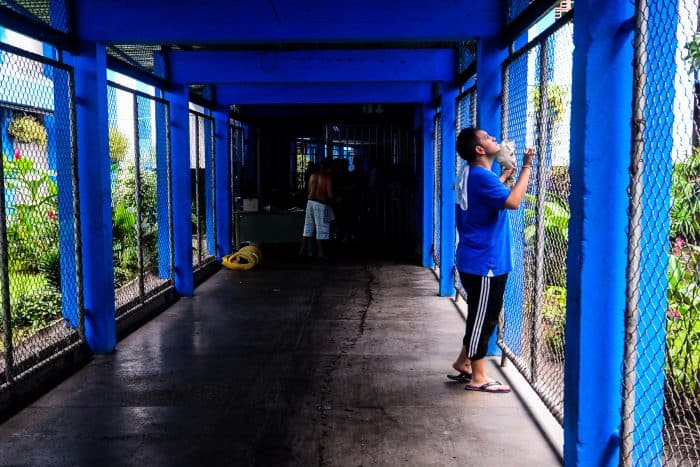
Preventive prison as the rule
In all, more than 2,500 people are currently being held in preventive or pretrial detention in Costa Rica’s 13 prisons, including San Sebastián.
A seismic ruling from sentencing Judge Roy Murillo, made public last week, called for the closure of San Sebastián, which prison officials said they will do over an 18-month period. In Murillo’s decision, he called the prison a “human cage” and a “giant dungeon” that strips prisoners of essential rights in its overcrowded, deteriorating cells.
At a recent panel on the subject of preventive prison, Murillo said images from inside San Sebastián reminded him of a rat infestation where the rodents climb over each other in septic tanks. He said that if he had to spend a few weeks in San Sebastián he would kill himself or immediately become addicted to drugs.
“No one who goes in there for six months is going to leave in an OK state of mind,” he said. “It’s up to us as judges to take these conditions into account when making our rulings.”
Murillo’s ruling to close San Sebastián could signal a turning point in the use of pretrial detention, or it could be a reactionary measure that has unintended consequences. If prosecutors continue to liberally request preventive prison for accused parties and judges continue to grant those requests, more minor criminals like Marín may be distributed among Costa Rica’s regular prisons, making overcrowding even worse.
Overall, the country’s penitentiaries are more than 50 percent over capacity, the Ombudsman’s Office reported last year.
Some prominent officials, like Chief Public Defender Marta Iris Muñoz, argue that the country needs to abstain from ordering preventiva for people accused of petty crimes and come up with more appropriate measures that fit the seriousness of the crime. The IACHR estimates that around two-thirds of inmates in preventive prison here are suspected of property crimes or drug-related offenses.
Muñoz has toured Costa Rica’s prisons to see firsthand the results of what she calls an excessive dependence on pretrial detention. She said that prosecutors and judges have bought into fear tactics to oppose reforms and continue to over-rely on preventive prison orders in pretrial hearings.
“I think this all stems from … the issue of personal security,” she said. Muñoz thinks those who espouse tough sanctions for perpetrators of petty crime haven’t considered how many individuals behind bars for such crimes haven’t even faced trial yet.
Muñoz and the Costa Rican Justice Ministry, which oversees the prison system and has long been motivated to curb overcrowding, believe there are better alternatives to preventive prison. Muñoz is among the main supporters of a new initiative to use electronic ankle bracelets to monitor accused persons to make sure they don’t disappear before trial. That way, individuals can remain in their homes, work, and go to school while awaiting trial or a resolution in their case.
The monitoring program, which former President Laura Chinchilla tried to introduce in 2013, seems to be finally taking off. The Justice Ministry is looking into buying the monitors, which could be available by the end of the year.
In the meantime, prosecutors say they frequently request pretrial detention because it’s the best option available under the law.
“We’ve found that [preventive prison] combines the strongest application of any precautionary measure and the judges agree,” said prosecutor Alexander Mora. “Whether it’s risk of flight or risk of recidivism, the penal code establishes the right to [request] preventive prison.”
This right is laid out in Article 239 of the country’s penal code, along with a list of factors that judges are supposed to consider when deciding whether or not to order preventive prison for a suspect.
Chief Public Defender Muñoz said these guidelines are used too liberally and judges sometimes fail to properly analyze the context of each case. She and human rights advocates cite horror stories about the comic disparity between crime and punishment in Costa Rica.
Muñoz and others said petty crime suspects don’t generally belong in preventive prison. And Muñoz said it doesn’t make sense to punish perpetrators of such crimes with long prison sentences, either, a trend in Costa Rican justice that has also contributed to overcrowding.
Since many are entering the system with preluding problems like mental disorders or drug addiction, Muñoz said public defenders have advocated for measures that can address these root causes.
“Alternatives like the bracelets allow us to not immediately lock people up but rather let them be in their homes where they can receive better attention for their problems than in a jail,” Muñoz said.
When Marín was released from San Sebastián on July 20, a court ordered that he maintain a fixed home address, look for a job and stay out of downtown San José. He must also sign in with authorities every 15 days while his case is investigated and he awaits the possibly of being brought to trial.
Marín admitted he’s struggled with drugs before, but said he’s been trying to stay clean to get a more stable job and provide for his two kids. During his second time behind bars, Marín said he had become all too aware that any drug or mental health problems people bring in to preventiva only get exacerbated.
“There’s no such thing as rehabilitation here,” Marín said of San Sebastián. “They keep you here for a few months, then they throw you out to the street again. And that’s why people keep coming back.”
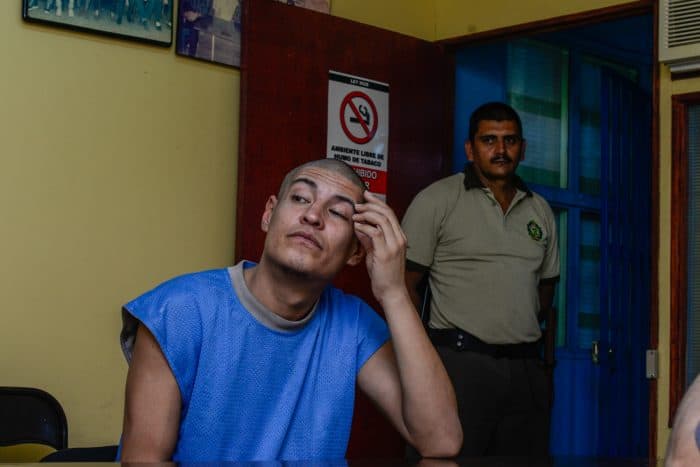
True democracy?
The IACHR attributes the creation of flagrancy courts in 2009 to the sharp rise in Costa Rica’s prison population — both for those being held in pretrial detention and those serving standard sentences.
Costa Rica created flagrancy courts in 2009 to address what was seen as a growing problem of petty crime on the country’s streets. Flagrancy courts give judges the power to rule on cases within 24 hours of a suspect being caught in the act of committing a crime. Preventive detention is frequently ordered, even for minor crimes like simple robbery.
Though swift justice seems like a sensible solution when defendants are caught red-handed, prison overpopulation rose from 10 percent to 46 percent in the six years after flagrancy courts were instituted, according to statistics from the Justice Ministry cited by IACHR.
Flagrancy court Judge Gloria Rojas, who had a long tenure as a prosecutor before being appointed a judge, estimated that she orders preventive prison more than half of the time it is requested by prosecutors.
“Right now preventive prison is the only mechanism we have to mitigate the risk of flight or risk for the victim.” Rojas said. “If this is the necessary mechanism to assure a person won’t flee, then preventive prison will be given.”
Human rights defenders note that when those caught or accused of minor crimes are ordered into pretrial detention, they are often put into the same crowded cells as those accused of far more serious offenses like murder and rape.
The major suspect in last year’s serial killing spree, who has already been linked to at least five of the nine victims through DNA evidence found on their bodies, is still in San Sebastián preventive prison, alongside petty thieves and people who have yet to be charged with any crime, in cell block B-2.
If you steal a cheap cell phone or you murder nine women, it all counts for the same within the walls of the country’s preventive prisons.
There are also more than 100 people at San Sebastián who have been convicted of crimes but haven’t been transferred to regular prisons.
Chief Public Defender Muñoz said the government needs to assess each inmate and, at the very least, separate those convicted from those still awaiting trial.
Muñoz, who said she makes regular visits to the country’s prisons, has called upon judges to make similar trips to better understand the problems that arise from overcrowding and an indiscriminate mix of inmates.
Judge Rojas and prosecutors have said that prison infrastructure isn’t their problem. They say they can only work with the laws they are given.
Rojas said she never plans to visit a prison. For one thing, she fears she could be attacked by a prisoner she may have sentenced. She said she’s aware of the conditions in prison but that doesn’t change her job.
“My only guide is the law, the constitution, and human rights,” Rojas said.
The judge also warned that people accused of small crimes can be part of larger criminal operations.
“There are judges who think organized crime is involved in a lot of these more minor offenses,” she said. “Why? Because we know they sell those goods to the black markets around the city known for reselling stolen items.”
Rojas said that when she does opt for more lenient measures than preventive prison, she tends to see accused back in her courtroom for other crimes.
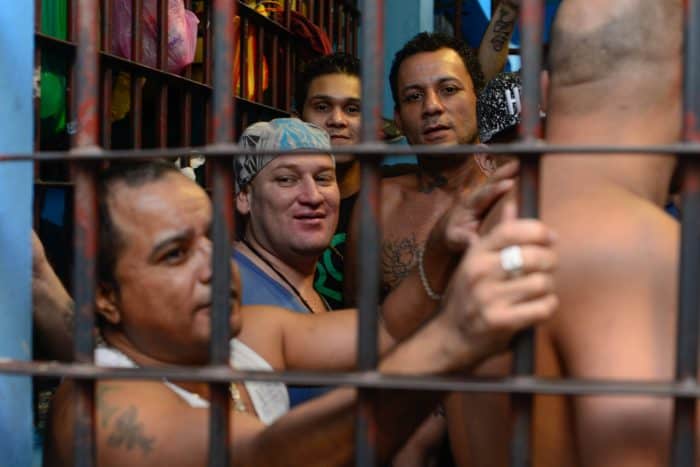
‘All your life ahead of you’
Jonathan de Jesús Rosales Herrera clasped his hands in prayer beneath his bent head as he whispered towards the wooden desk where he sat with his public defender. He then looked over to his mother, one of only two people sitting in the audience of the courtroom, and smiled before turning back to the judge who, moments earlier, ordered Rosales be transferred to house arrest.
“Thank you,” said the 20-year-old with a baby face. “God bless you.”
Though he had previously been sentenced to three years and four months in prison for aggravated robbery, today the judge had decided to let Rosales serve out his sentence under house arrest where he’ll be monitored with one of the electronic bracelets when they’re available.
“Take this opportunity that life just gave you,” flagrancy court Judge Edwin Reyes said. “You’re too young to be here. You have all your life ahead of you.”
Rosales had been in preventive prison since March 20, after he and an accomplice stole a cellphone valued at ₡25,000, about $40, from a man. He wasn’t carrying a weapon and didn’t use force against the victim, but he was charged with aggravated robbery because there were two assailants involved.
Rosales was ultimately given a reprieve from prison because he has a stable job in Escazú and a verifiable home address at his mother’s house where authorities can check in on him. Following months in the hell of San Sebastián, he got a second chance on his young life.
A pair of lawmakers are trying to pass a bill in the Legislative Assembly that would make nonviolent property crimes of anything less than ₡210,000 (roughly $385) for first-time offenders like Rosales punishable by mandatory work rather than prison time. With such a high proportion of detainees behind bars for minor crimes, the bill, if passed, has the potential to sharply reduce prison populations and make sure first-time offenders like Rosales don’t receive punishment that’s disproportional to the severity of their crime.
Justice Minister Sánchez went before the Assembly at the end of June to plead for the reform.
“Passing these reforms will make for more rational application of the laws,” she said.
But Sánchez and other would-be reformers have harsh critics. Former Justice Minister and current criminal lawyer Juan Diego Castro is strongly against any lessening of punishment for petty crimes.
“The Court and the Assembly will give thieves permission to rob liberally, $400 each time. Legal stupidity!” Castro posted on his Facebook page in Spanish in response to the plan. The Tico Times made multiple requests to interview Castro through his assistant Fabían Meza, but the request went unfulfilled.
Meza said international organizations like the IACHR are only interested in the rights of criminals and that, according to Castro’s team, more than 1,000 convicted criminals are on the lam because they weren’t sent to preventive prison while their cases played out. Figures from the justice system show that during 2015, just over 600 defendants didn’t show up to court.
Castro and other adherents to a tough-on-crime approach may be winning the battle: the bill that would cancel harsh sentences for petty theft has been in the Assembly for 16 months now with no sign of movement.
Other plans have been just as difficult to implement. Even the Justice Ministry’s historically successful semi-institutional program, which puts qualifying prisoners back into their homes under strict guidelines and monitoring, is always met with backlash from a terrified public that sees only the words “prisoner release” in headlines and television reports.
In April, the ministry received a judge’s order mandating the release of 380 prisoners from Alajuela’s Gerardo Rodríguez, the country’s most overcrowded prison, into the semi-institutional program to ease pressure off the center that couldn’t house any more inmates. The storm of complaints from the general population and government agencies like the Public Ministry, which oversees the country’s prosecutors, ultimately led to the release being canceled.
Judge Murillo, the one who ordered San Sebastián closed, knows how controversial such orders can be. In 2013, he ordered releases and transfers for hundreds of prisoners from San Sebastián. Murillo then came under a storm of criticism when at least three of the released inmates were accused for committing new crimes, including one who became the main suspect in a homicide case.
The judge maintains those orders were necessary to combat overcrowding and honor the rights of prisoners.
In November of last year, a court ruled that Justice Ministry representatives needed to cut back on overpopulated prisons. That ruling came weeks after a previous order had expired from inaction.
The latest suspension in releasing prisoners to the semi-institutional program continues to frustrate officials like Prison System Director Reynaldo Villalobos. He said there’s a misunderstanding in Costa Rican society about what prison should be.
“The role of the national penitentiary system is to try to reincorporate prisoners back into their families and community in the quickest and most positive manner possible,” Villalobos said.
He said the Public Ministry, which includes prosecutors, interfered with last year’s court decision to relieve prisons and chose to ignore the positives of the semi-institutional program.
“We’ve been doing this for more than 40 years with good results,” he told The Tico Times.
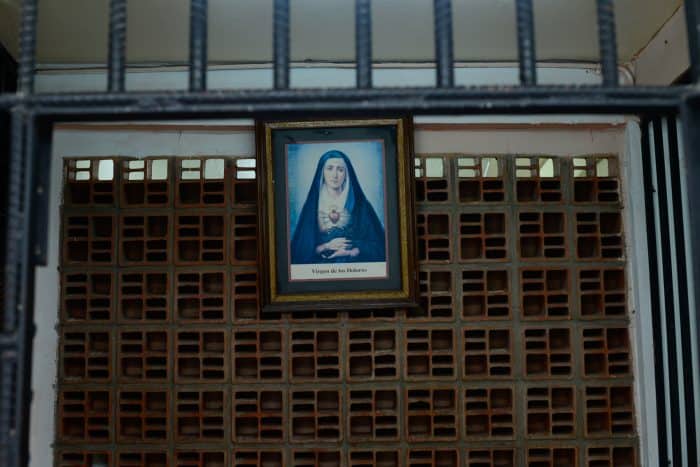
Reconstructing lives
Though 60 percent of the people who pass through San Sebastián leave within two months, there are some who spend much more time here. Legally, a person cannot spend more than 12 months in pretrial detention in Costa Rica for ordinary cases, though there are reports of prisoners who have been here for eight years without a decision in their case.
Now-infamous U.S. sex tourist David Strecker, known as “Cuba Dave,” has been in preventive detention for nearly a year awaiting a possible trial, though the 65-year-old was moved earlier this year from San Sebastián to the the senior wing of La Reforma Correctional Center.
Strecker said he’s still never been presented with a formal charge, but prosecutors accuse him of violating the country’s Sex Tourism Law, which makes the promotion of Costa Rica as a sex tourism destination illegal, despite prostitution being legal here.
As a foreigner, prosecutors deem Strecker’s risk of flight to be too high to let him out until a potential trial, even though authorities confiscated his passport.
Representatives from the Inter-American Commission of Human Rights warned about the consequences of keeping so many people in preventive prison for long stints. Not only is there a social stigma applied to them for the rest of their lives, but it’s common for inmates to develop psychological problems from their time in jail.
“The Commission recalls that persons in custody suffer greatly by the loss of income and the forced separation from family and community,” the IACHR report stated. “Also they suffer the psychological and emotional impact of being deprived of liberty without being convicted.”
Multiple prisoners in San Sebastián told The Tico Times that some inmates are forced to sleep in the bathrooms next to the urinals and that inmates in need of medical attention are often ignored and resort to cutting themselves to get the attention of guards.
Everyone from Judge Rojas to public defenders to the Justice Ministry agree that Costa Rica’s pretrial detention centers are disproportionately filled with drug addicts and impoverished people. Many of those accused of simple robbery or theft, whether it’s stealing a cell phone or a purse, say they do so to survive.
And as rehabilitation centers in the country remain few and underfunded, González said drug addicts are often put in chains before they’re given a chance to free themselves of addiction. She and public defenders, who represent the majority of the country’s preventive prison population, say the government needs to invest more in rehabilitation to prevent these minor crimes.
“What we need to do to really tackle the issue of overcrowding is construct different lives,” Muñoz said. “If you’re not giving purpose to these people then they are without ambition. More than anything, they want to avoid going back to prison, but if you leave [prison] without work, without schooling, it all ends up the same.”
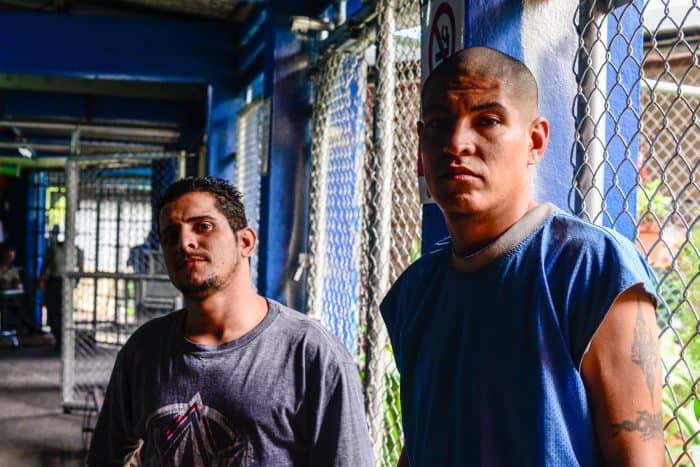
‘We don’t ever think about tomorrow’
When Hector Salas opens his mouth, there’s a gap in place of his two front teeth. He said they were knocked out by police when he was detained. Though he’s already been charged and sentenced to two years behind bars, he remains in San Sebastián’s preventive prison.
Salas stole a cell phone on May 1, prosecutors said. He admits to the robbery. He said he was hungry and got desperate.
“A lot of times we commit errors, but these are errors that can have a solution,” Salas said. “We haven’t killed anyone. We haven’t done harm to a single person.”
He has been in San Sebastián for more than three months now, in the B-3 cell block that has a capacity to hold 126 inmates. On a June 27 visit, the cell block was holding 285 prisoners.
During a sit-down interview in May at the now-closing San Sebastián, Salas and Marín both said they felt like their lives and the lives of their families had been made worse than ever after their time in pretrial detention. They both have kids and said they had no way to support their children from behind bars.
This is how the problems that were never addressed by stuffing more and more people into prison eventually flood back into the streets, argue advocates of eliminating prison time for petty theft.
“What kind of city are we going to leave for ourselves if we just keep relying on these vindictive penalties?” said Diana Montero, a supervisor at the Public Defenders’ Office.
“We only think, ‘That’s good that they’re locked up so that they’re not anywhere near us.’ But we don’t ever think about tomorrow when they’re going to leave [prison] even worse off and it’s going to be our children and our grandchildren who have to live among these people who haven’t improved.”
The proposed closing of San Sebastián is sure to shake up the preventive prison system, and could force those in the judiciary to lean on alternatives to pretrial detention. Or it could equate to even less prison space for the same number of prisoners entering the system.
From the murky view inside Costa Rica’s prisons, the future is as unclear as ever.

